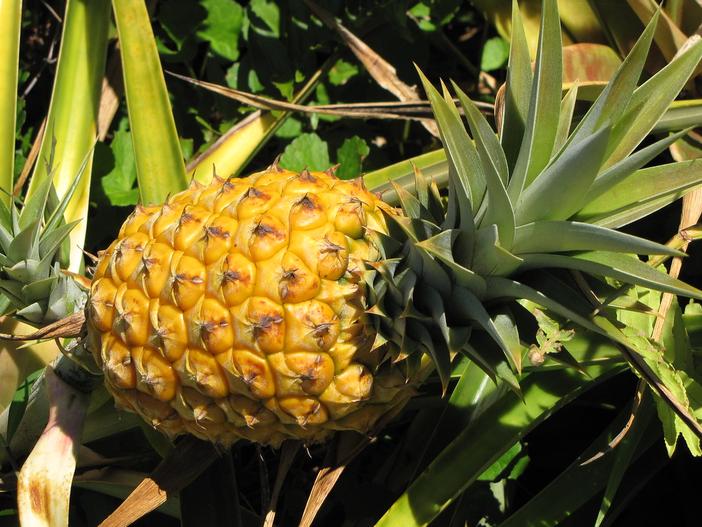Pineapple
(Ananas comosus)
Pineapple (Ananas comosus)
/
/

Forest and Kim Starr
CC BY 2.0
Image By:
Forest and Kim Starr
Recorded By:
Copyright:
CC BY 2.0
Copyright Notice:
Photo by: Forest and Kim Starr | License Type: CC BY 2.0 | License URL: https://creativecommons.org/licenses/by/2.0/ | Uploader: Starr Environmental | Publisher: Flickr




























































Estimated Native Range
Summary
Ananas comosus, commonly known as Pineapple, is an evergreen perennial herb originally from the tropical regions of South America, specifically Southern Brazil and Paraguay. This plant is widely cultivated in tropical and subtropical regions around the world for its edible fruit. The pineapple plant typically grows to a height of 1.0 to 1.5 meters (3 feet 3 inches to 4 feet 11 inches) and features a short, stocky stem with tough, waxy leaves. Its unique fruit develops from a dense spiral of up to 200 individual flowers that merge to form a single multiple fruit. Pineapples are known for their sweet and tangy flavor and are a staple in both culinary and beverage applications.
In cultivation, the pineapple plant prefers full sun and does well in a variety of soil types, provided they offer good drainage. It requires medium amounts of water, with soil allowed to dry out between waterings. The plant has a relatively fast growth rate, maturing within a year, and can be propagated from offsets or side shoots. Pineapples are not only grown for their fruit but also as ornamental plants, such as the variegated cultivar A. comosus ’Variegatus’. This variety, when grown as a houseplant, requires direct sunlight and temperatures between 18 to 24 °C (64 to 75 °F), with a minimum winter temperature of 16 °C (61 °F). High humidity is beneficial, and repotting should be done annually until the container size reaches 20 centimeters (8 inches). Potential problems include diseases such as root rot and pests like mealybugs and scale insects.CC BY-SA 4.0
In cultivation, the pineapple plant prefers full sun and does well in a variety of soil types, provided they offer good drainage. It requires medium amounts of water, with soil allowed to dry out between waterings. The plant has a relatively fast growth rate, maturing within a year, and can be propagated from offsets or side shoots. Pineapples are not only grown for their fruit but also as ornamental plants, such as the variegated cultivar A. comosus ’Variegatus’. This variety, when grown as a houseplant, requires direct sunlight and temperatures between 18 to 24 °C (64 to 75 °F), with a minimum winter temperature of 16 °C (61 °F). High humidity is beneficial, and repotting should be done annually until the container size reaches 20 centimeters (8 inches). Potential problems include diseases such as root rot and pests like mealybugs and scale insects.CC BY-SA 4.0
Plant Description
- Plant Type: Herb
- Height: 3-4 feet
- Width: 2-4 feet
- Growth Rate: Slow
- Flower Color: Purple
- Flowering Season: Summer
- Leaf Retention: Evergreen
Growth Requirements
- Sun: Full Sun
- Water: Medium
- Drainage: Fast, Medium
Common Uses
Edible*Disclaimer: Easyscape's listed plant edibility is for informational use. Always verify the safety and proper identification of any plant before consumption., Fragrant, Potted Plant, Showy Flowers
Natural Habitat
Tropical regions of South America, specifically Southern Brazil and Paraguay
Other Names
Common Names: Piña , 鳳梨
Scientific Names: Ananas comosus , Ananas bracteatus , Ananas sativa , Bromelia comosa , Ananas acostae , Ananas argentata , Ananas aurata , Ananas bracteatus subsp. hondurensis , Ananas bracteatus subsp. paraguayensis , Ananas bracteatus var. paraguayensis
GBIF Accepted Name: Ananas comosus (L.) Merr.